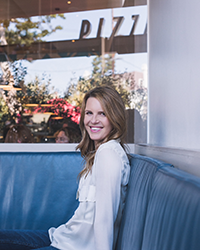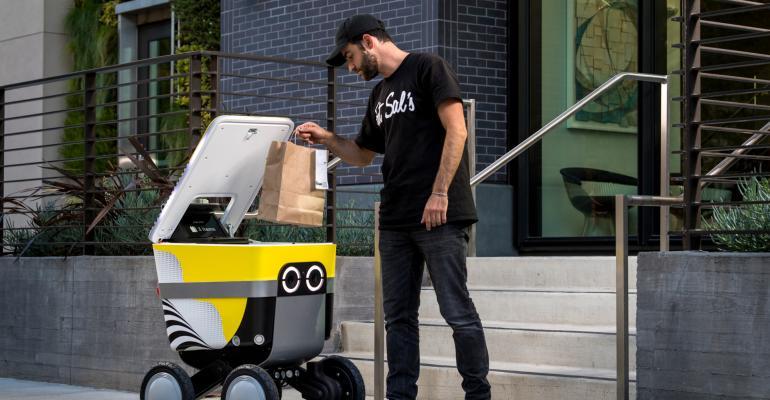As the originator of the first Cupcake ATM back in 2012, I am no stranger to innovation. However, I was amazed by my recent robot encounter at a local Los Angeles restaurant. What was once a distant fantasy in shows like “The Jetsons” was now a reality as it cleared my dishes! While ChatGPT has been dominating the 24-hour news cycle, it’s clear that the restaurant industry is undergoing a digital transformation of its own. From robotic table service to takeout by drone and drive-thru ordering via fast-food AI chatbots, there’s no denying dining technology is here and poised to revolutionize the way we eat.
As humans, we often have conflicted feelings about technology. We’re simultaneously fascinated and frightened by it, particularly when it starts to replace human workers. But before you start to panic, consider the array of automation restaurants already rely on, from mixers to dishwashers. We’re simply moving on to the next course in our meal of progress.
If selecting spicy tuna rolls from a conveyor belt and crafting a barista-grade coffee from a vending machine are the appetizer of automation, just think how droids, drones and AI chatbots spice up our entrées — with choice and convenience right at our fingertips.
Droids and drones
Just like my trusty robot server, what was once a wild idea is now becoming the norm. Droids dish dim sum in New York City, serve sushi in Philadelphia and maneuver Mexican in Memphis. And it’s not just a big-city phenomenon. Kitchens across the country from Minot, North Dakota, to Tustin, California, are using robots to cut costs, increase customer satisfaction (including prime photo opps) and prevent server burnout and injury. With sky-high inflation, supply chain woes and labor market disruptions continuing to plague the industry, robots may also be the key to restaurant survival.
While a hefty investment upfront, consider that for about $2.50 an hour, a robot allows waitstaff to focus on what matters most: the overall dining experience. When a robot takes over the labor-intensive parts of a job, it frees servers to spend more time with customers and reduces the chance of injury. Those who dine among droids discover more efficient and engaged service, while their bosses benefit from fewer staffing shortages and a break from pricey workers’ compensation claims.
Outside the four walls of restaurants, new technology revolutionizes the delivery service industry by addressing its inefficiencies, from high commission rates and poor delivery reliability to traffic and pollution woes. One such solution is Coco the robot, a compact, human-piloted electric robot navigating sidewalks to deliver food within a few miles.
But the need for innovation extends beyond land-based transportation, especially in cities like Los Angeles with notoriously congested traffic. Fortunately, a drone-based food delivery service has received clearance from the U.S. Federal Aviation Administration to pilot a new kind of takeout. This approach offers a logical solution to the expensive restaurant delivery problem while also showcasing the limitless potential of airborne delivery services. Just imagine Sprinkles and Pizzana taking to the skies with Flytrex, which already delivers Starbucks' Pup Cups and Pink Drinks, as well as a few Whataburgers outside Dallas. The future of food delivery is up in the air, and we're here for it!
Improve the recipe
While innovation may sound like a heady concept, it's really just about enhancing what already exists or, as I describe it in my book “Sweet Success,” improving the recipe. Innovation is a mindset that challenges the status quo while also adding value, and the best ideas often arise from bumping up against frustration until a breakthrough occurs. Years ago, when a late-night pregnancy craving for a dark chocolate cupcake went unsatisfied, I imagined a world where hormonal cravings could be sated any time of day. My solution? The Sprinkles ATM. Using innovative and creative thinking, I reimagined Sprinkles bakeries’ “office hours” to create an always-on dining experience.
Crisis (for me anyway) was averted with cupcakes on demand in 2012, long before “Netflix and chill” changed how we consume television and film. Taking what was old, making it new, and improving it, changed Sprinkles’ trajectory and lit my innovation pilot light.
Of course, as with any new technology, there are bound to be a few hiccups along the way. A friend recently shared a video of a robot transporting her food delivery to her hotel room door. She was thrilled to see it in action, but then came the moment of truth — how to extract the food from the machine? In the next clip, we see the server darting down the hallway with the food still safely inside. It's a hilarious reminder of the fact that while technology is intended to improve our lives, it can often go wrong and cause its own chaos.
In the initial days of the Sprinkles Cupcake ATM, demand for our contactless cupcake delivery system blew through our expectations, causing the machine’s parts to frequently burn out. To make sure our precious novelty didn’t go down, we stationed our trusty IT person behind the machine day and night, replacing worn-out parts in real time. A small price to pay for cutting-edge innovation.
Seeing the future
The restaurant industry is amid an exciting technological revolution that changes the way we dine. From robot servers to drone deliveries, the possibilities for improving the food experience seem endless. Technology has the power to make dining more convenient, efficient and enjoyable than ever before, and it’s essential for restaurants to embrace these innovations to stay competitive.
Of course, the human touch and hospitality will always be an integral part of the dining experience, but with the right balance of technology and personal service, we can create a truly exceptional dining experience.
 AUTHOR BIO
AUTHOR BIO
Candace Nelson is a Los Angeles-based entrepreneur and accomplished pastry chef known for co-founding Sprinkles, the world’s first cupcake bakery, and most recently Pizzana, a Michelin Bib Gourmand Neo-Neapolitan pizzeria with locations in Los Angeles and Dallas. Fueled by her knack for elevating simple concepts into breakthrough brands, Candace cofounded CN2 Ventures in 2020 to invest in early stage and growth stage companies in the retail, food, direct-to-consumer and branded consumer product sectors. Candace's love for supporting fellow entrepreneurs is further revealed in her new book, Sweet Success, which showcases how to turn one's passion into a business inspired by her professional journey. Candace is also the author of the New York Times Best Seller The Sprinkles Baking Book, executive producer of and judge on Netflix’s Sugar Rush, and an executive producer on Hulu's forthcoming Best in Dough.





